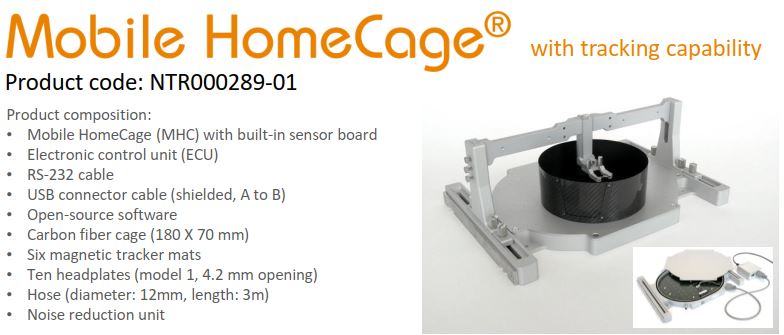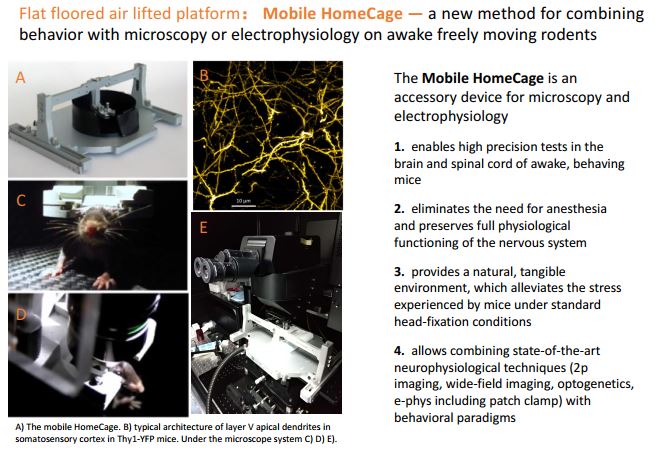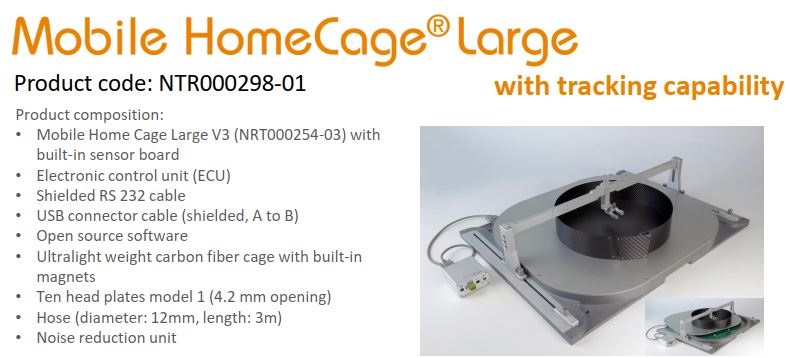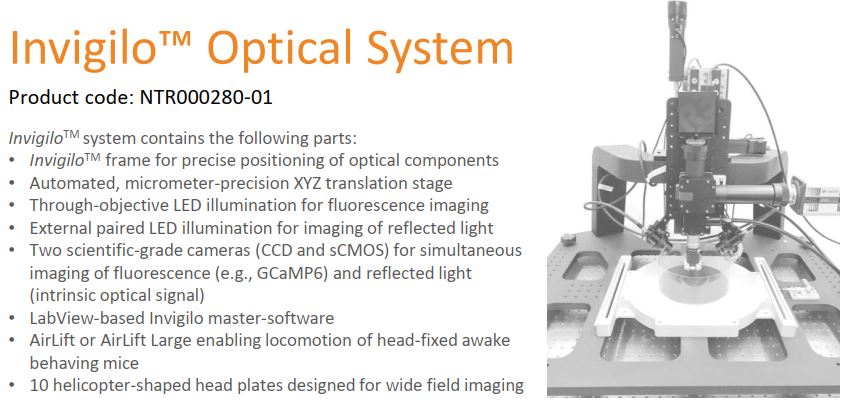
Mobile HomeCage (MHC) enables neurophysiological experiments in non-anesthetized, head-fixed but otherwise freely-moving mice. Test animal’s head remains firmly fixed to the MHC frame, while the animal navigates a carbon-fiber cage suspended on a cushion of air. Mice can move the cage easily with their paws, which creates an illusion of walking around the cage and alleviates the stress otherwise experienced by animals under standard head-fixation conditions. Tracking capability allows combining high precision techniques, such as 2-photon imaging and patch-clamp, with behavioral readouts: tracker software records the mouse’s movement trajectory and speed, and controls external devices through TTL trigger signals activated by the mouse’s behavior during closed-loop experiments.

Features and Benefits:
Enables high precision imaging, single cell electrophysiology and optogenetic stimulation in the brain or spinal cord of awake animals,
and eliminates the biases associated with the use of anesthetics;
Fits under most commercial two-photon microscopes;
Tracker parts are built into the air dispenser and carbon cage - they do not require extra space;
Reduces the run-up time to experiments: illusion of voluntary movement and presence of natural stimuli effectively reduce stress.
Provides natural olfactory, tactile and visual stimuli; eliminates reliance on virtual reality (VR);
Provides easy access to lateral parts of the brain (enabled by clamp rotation);
Provides actionable data on the mouse’s trajectory, movement velocity and acceleration;
Allows tracking in light and dark condition (unlike camera-based tracking);
Records data with high spatial and temporal resolution;
Makes it possible to control external devices in closed-loop experiments via TTL outputs.

Mobile HomeCage Large with tracking capabilities (MHC-L-T V1) enables neurophysiological experiments in non-anesthetized, head-restrained but otherwise freely moving mice. The animal’s head remains firmly fixed to the MHC-L frame, while the animal navigates an ultralight weight cage suspended on a cushion of air. Large cage diameter enables place cell recording and allows greater versatility in designing such complex behavioral tests as maze navigation and conditioning. Tracking ensures seamless integration with behavioral research: tracker software records the mouse’s movement trajectory and speed, and controls external devices through TTL trigger signals activated by the mouse’s behavior during closed-loop experiments.
Features and Benefits:
High precision imaging/recordings in the brain of awake behaving mice;
• Integration with behavioral research, including maze navigation;
• Efficient stress reduction (under head-restraint conditions);
• Fast ramp-up to experiments: easy assembly, short training (no anesthetics during training or testing);
• Possibility to study place cells (in a donut-maze);
• Locomotion tracking (with high temporal and spatial resolution);
• Real-time synchronization of tracking software with external imaging/recording software, stimulation and reward systems;
• Compact and user-friendy design (tracking device built into the air dispenser);
• Open source software.

In vigilo means “in awake”, “in conscious” organism. InvigiloTM is a turnkey solution for multi-channel wide-field
optical imaging and optogenetic stimulation of the rodent brain. The centerpiece of InvigiloTM is the Mobile
HomeCage®, an innovative device that eliminates the need for anesthesia (and the biases that anesthetics
introduce to the research), alleviates the stress experienced by animals under standard head-fixation conditions
and enriches the experiment by exposing the animals to a variety of tactile, olfactory and visual stimuli.
With the Invigilo™ system you can:
• Perform wide-field imaging of multiple cortical areas in an awake behaving mouse;
• Use simultaneously acquired blood oxygenation level dependent (BOLD) signal for correction of Ca2+
imaging (need to correct for BOLD was demonstrated in Ma et al./Hillmann, 2016);
• Image neuronal Ca2+ dynamics simultaneously with optogenetic or sensory stimulation;
• Combine imaging/stimulation with behavioral readouts, e.g. motion capture or locomotion tracking;
• Control all components through a single user-friendly graphic user interface of the master-software;
• Pay half the price of a barebone confocal microscopy system.



